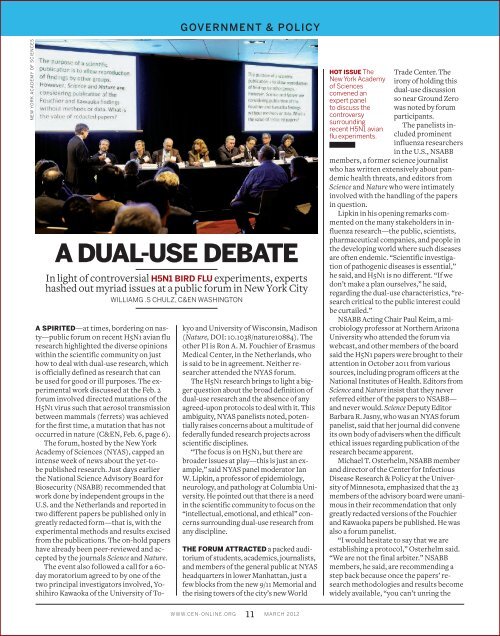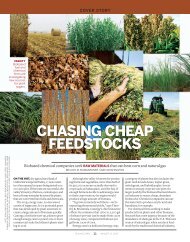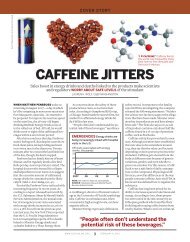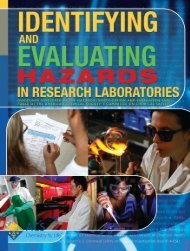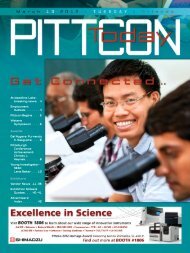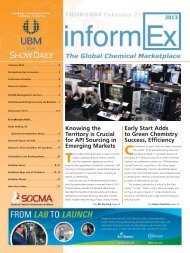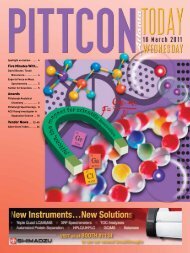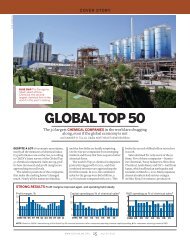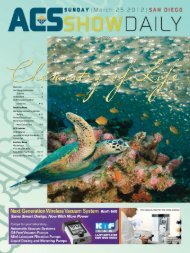focus on life sciences - Chemical & Engineering News - American ...
focus on life sciences - Chemical & Engineering News - American ...
focus on life sciences - Chemical & Engineering News - American ...
- No tags were found...
You also want an ePaper? Increase the reach of your titles
YUMPU automatically turns print PDFs into web optimized ePapers that Google loves.
GOVERNMENT & POLICYNEW YORK ACADEMY OF SCIENCESA DUAL-USE DEBATEIn light of c<strong>on</strong>troversial H5N1 BIRD FLU experiments, expertshashed out myriad issues at a public forum in New York CityWILLIAM G . S CHULZ , C&EN WASHINGTONA SPIRITED—at times, bordering <strong>on</strong> nasty—publicforum <strong>on</strong> recent H5N1 avian fluresearch highlighted the diverse opini<strong>on</strong>swithin the scientific community <strong>on</strong> justhow to deal with dual-use research, whichis officially defined as research that canbe used for good or ill purposes. The experimentalwork discussed at the Feb. 2forum involved directed mutati<strong>on</strong>s of theH5N1 virus such that aerosol transmissi<strong>on</strong>between mammals (ferrets) was achievedfor the first time, a mutati<strong>on</strong> that has notoccurred in nature (C&EN, Feb. 6, page 6).The forum, hosted by the New YorkAcademy of Sciences (NYAS), capped anintense week of news about the yet-tobepublished research. Just days earlierthe Nati<strong>on</strong>al Science Advisory Board forBio security (NSABB) recommended thatwork d<strong>on</strong>e by independent groups in theU.S. and the Netherlands and reported intwo different papers be published <strong>on</strong>ly ingreatly redacted form—that is, with theexperimental methods and results excisedfrom the publicati<strong>on</strong>s. The <strong>on</strong>-hold papershave already been peer-reviewed and acceptedby the journals Science and Nature .The event also followed a call for a 60-day moratorium agreed to by <strong>on</strong>e of thetwo principal investigators involved, YoshihiroKawaoka of the University of Tokyoand University of Wisc<strong>on</strong>sin, Madis<strong>on</strong>( Nature, DOI: 10.1038/nature10884 ). Theother PI is R<strong>on</strong> A. M. Fouchier of ErasmusMedical Center, in the Netherlands, whois said to be in agreement. Neither researcherattended the NYAS forum.The H5N1 research brings to light a biggerquesti<strong>on</strong> about the broad definiti<strong>on</strong> ofdual-use research and the absence of anyagreed-up<strong>on</strong> protocols to deal with it. Thisambiguity, NYAS panelists noted, potentiallyraises c<strong>on</strong>cerns about a multitude offederally funded research projects acrossscientific disciplines.“The <str<strong>on</strong>g>focus</str<strong>on</strong>g> is <strong>on</strong> H5N1, but there arebroader issues at play—this is just an example,”said NYAS panel moderator IanW. Lipkin, a professor of epidemiology,neurology, and pathology at Columbia University.He pointed out that there is a needin the scientific community to <str<strong>on</strong>g>focus</str<strong>on</strong>g> <strong>on</strong> the“intellectual, emoti<strong>on</strong>al, and ethical” c<strong>on</strong>cernssurrounding dual-use research fromany discipline.THE FORUM ATTRACTED a packed auditoriumof students, academics, journalists,and members of the general public at NYASheadquarters in lower Manhattan, just afew blocks from the new 9/11 Memorial andthe rising towers of the city’s new WorldHOT ISSUE TheNew York Academyof Sciencesc<strong>on</strong>vened anexpert panelto discuss thec<strong>on</strong>troversysurroundingrecent H5N1 avianflu experiments.Trade Center. Their<strong>on</strong>y of holding thisdual-use discussi<strong>on</strong>so near Ground Zerowas noted by forumparticipants.The panelists includedprominentinfluenza researchersin the U.S., NSABBmembers, a former science journalistwho has written extensively about pandemichealth threats, and editors fromScience and Nature who were intimatelyinvolved with the handling of the papersin questi<strong>on</strong>.Lipkin in his opening remarks commented<strong>on</strong> the many stakeholders in influenzaresearch—the public, scientists,pharmaceutical companies, and people inthe developing world where such diseasesare often endemic. “Scientific investigati<strong>on</strong>of pathogenic diseases is essential,”he said, and H5N1 is no different. “If wed<strong>on</strong>’t make a plan ourselves,” he said,regarding the dual-use characteristics, “researchcritical to the public interest couldbe curtailed.”NSABB Acting Chair Paul Keim, a microbiologyprofessor at Northern Ariz<strong>on</strong>aUniversity who attended the forum viawebcast, and other members of the boardsaid the H5N1 papers were brought to theirattenti<strong>on</strong> in October 2011 from varioussources, including program officers at theNati<strong>on</strong>al Institutes of Health. Editors fromScience and Nature insist that they neverreferred either of the papers to NSABB—and never would. Science Deputy EditorBarbara R. Jasny, who was an NYAS forumpanelist, said that her journal did c<strong>on</strong>veneits own body of advisers when the difficultethical issues regarding publicati<strong>on</strong> of theresearch became apparent.Michael T. Osterhelm, NSABB memberand director of the Center for InfectiousDisease Research & Policy at the Universityof Minnesota, emphasized that the 23members of the advisory board were unanimousin their recommendati<strong>on</strong> that <strong>on</strong>lygreatly redacted versi<strong>on</strong>s of the Fouchierand Kawaoka papers be published. He wasalso a forum panelist.“I would hesitate to say that we areestablishing a protocol,” Osterhelm said.“We are not the final arbiter.” NSABBmembers, he said, are recommending astep back because <strong>on</strong>ce the papers’ researchmethodologies and results becomewidely available, “you can’t unring theWWW.CEN-ONLINE.ORG 11 MARCH 2012


